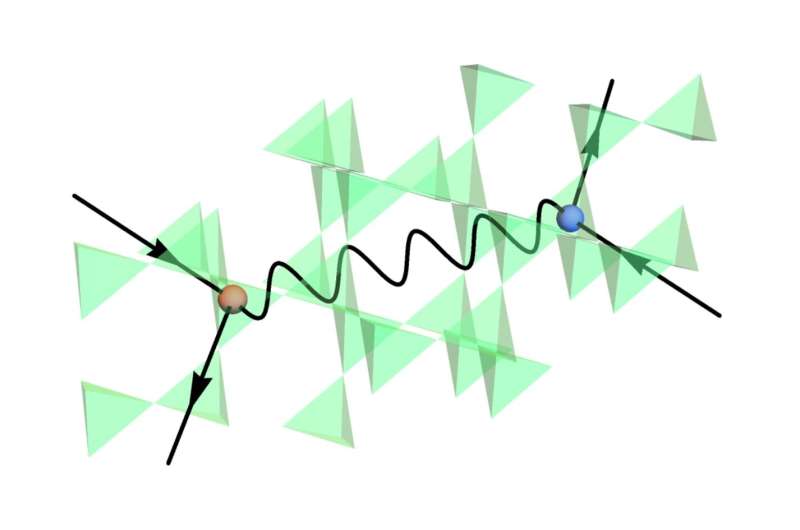October 1, 2021 feature
Study finds that the fine structure constant of quantum spin ice is large

Quantum electrodynamics (QED) is the fundamental quantum theory governing the behavior of charged particles and light in vacuum. The strength of the interactions in QED is quantified by the fine structure constant α, which in our universe is both immutable and eternal (α ~ 1/137). The smallness of the fine structure constant has far-reaching consequences in the physical world—it determines the number of stable chemical elements, enables long-distance, light-based communication, etc.
One of the great recent insights of condensed matter physics is that QED-like theories describe the behavior of quantum spin ice, a class of fractionalized magnets. Rather than being ordered in a simple pattern, the atomic spins in these systems fluctuate in intricate patterns down to the lowest measurable temperatures. The resulting phase is characterized by the presence of magnetic charges which interact with light-like waves in the spin background.
Researchers at Boston University, Massachusetts Institute of Technology (MIT) and Max-Planck-Institut für Physik komplexer Systeme have recently carried out a study investigating the fine structure constant that emerges in the QED of quantum spin ice. Their paper, published in Physical Review Letters, shows that in quantum spin ice, this fundamental constant is large, which means that these magnetic systems could be ideal for studying physical phenomena arising from strong particle interactions.
"We were thinking about possible signatures of the emergent QED in quantum spin ice and found that the most distinctive signatures involved effects of interactions between the emergent charges and photons," Christopher R. Laumann and Siddhardh C. Morampudi, two of the researchers who carried out the study, told Phys.org via email. "We then realized that the basic dimensionless number (the emergent fine-structure constant) characterizing the strength of this interaction was not yet determined in any previous work, and previous works had only focused on characterizing the emergent speed of light."
Laumann, Morampudi and their colleagues set out to investigate the fine structure constant of quantum spin ice, as they believed this would offer a more complete characterisation of their QED. The observation of a relatively large α value was a pleasant surprise for them, as such a value would enhance the interaction-mediated signatures of the emergent QED.
"Using large-scale exact diagonalization to obtain the energy cost of an electric flux tube, we were able to extract the electric charge," Laumann and Morampudi said. "This then allowed us to get from the lattice model to the long-wavelength emergent QED in computationally accessible finite-size systems."
The numerical simulations carried out by Laumann, Morampudi and their colleagues are the first to calculate the fine structure constant in an emergent QED, specifically one realized in quantum spin ice. The team showed that in the system they simulated, the α constant is typically one order of magnitude larger than the fine-structure constant of usual QED. In addition, they demonstrated that in quantum spin ice the constant can be tuned all the way from zero to the strongest coupling with which QED confines.
"The fine-structure constant of usual QED is small and fixed as provided by nature," Laumann and Morampudi said. "Having an emergent QED with a large and also tunable fine-structure constant provides a nice playground for understanding processes in QED which are heavily suppressed due to the small coupling."
One of the primary theoretical tools for studying quantum field theories is perturbation theory. Over the past few decades, however, many researchers have begun to explore what happens to field theories at strong coupling, in instances where perturbation theory is not a particularly useful construct.
"This has led to a wide variety of non-perturbative tools whose effectiveness can be tested if we have an experimental playground for strong-coupling QED in quantum spin ice," Laumann and Morampudi said. "Our work also identifies quantum spin ice as a great target for fast-evolving quantum simulators, with the promise of uncovering interesting physics of strong-coupling QED as a reward."
In recent years, a growing number of physicists have started conducting studies investigating quantum spin ice candidates, particularly rare-earth pyrochlores. Some of the candidates identified in these studies could exhibit additional interactions that causes the systems to become ordered, rather than remaining in a quantum spin liquid phase. The large fine structure constant calculated by Laumann, Morampudi and their colleagues implies the presence of significant interaction-mediated effects, such as a large enhancement of the inelastic neutron scattering cross-section near threshold.
"There have been tantalizing hints of the right physics in some of the materials, but disorder and the small energy scales (limiting experimental resolution in neutron scattering for example) have been limiting factors so far," Laumann and Morampudi said. "In our next studies, we plan to explore more implications of the large fine structure constant in potential realizations of quantum spin ice, and push towards simulations of them in near-term quantum computers. Our hope is to better understand how open questions in strong-coupling QED could potentially be answered in such settings."
More information: Salvatore D. Pace et al, Emergent fine structure constant of quantum spin ice is large. Physical Review Letters(2021). DOI: 10.1103/PhysRevLett.127.117205 journals.aps.org/prl/abstract/ … ysRevLett.127.117205
Siddhardh C. Morampudi et al, Spectroscopy of Spinons in Coulomb Quantum Spin Liquids, Physical Review Letters (2020). DOI: 10.1103/PhysRevLett.124.097204
Journal information: Physical Review Letters
© 2021 Science X Network





















